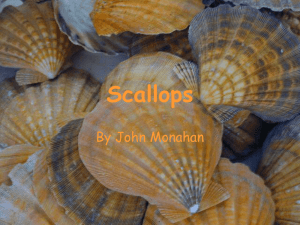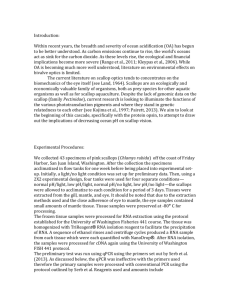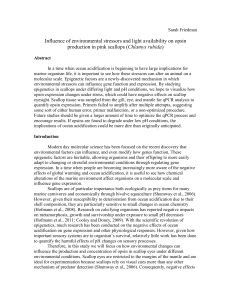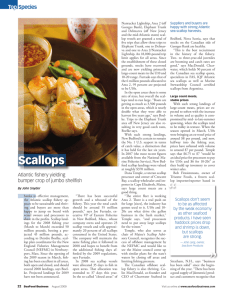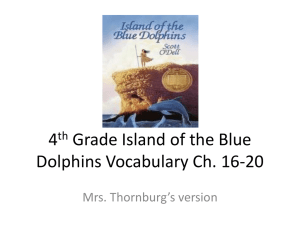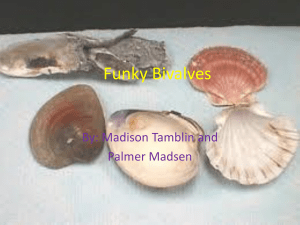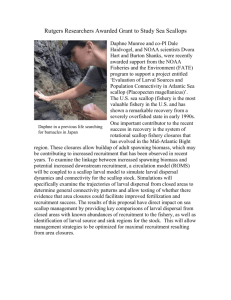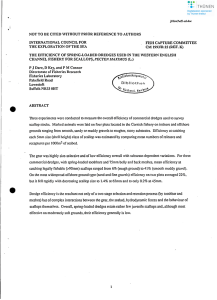AmandaFitch_FISH441 374KB Dec 02 2013 08:11
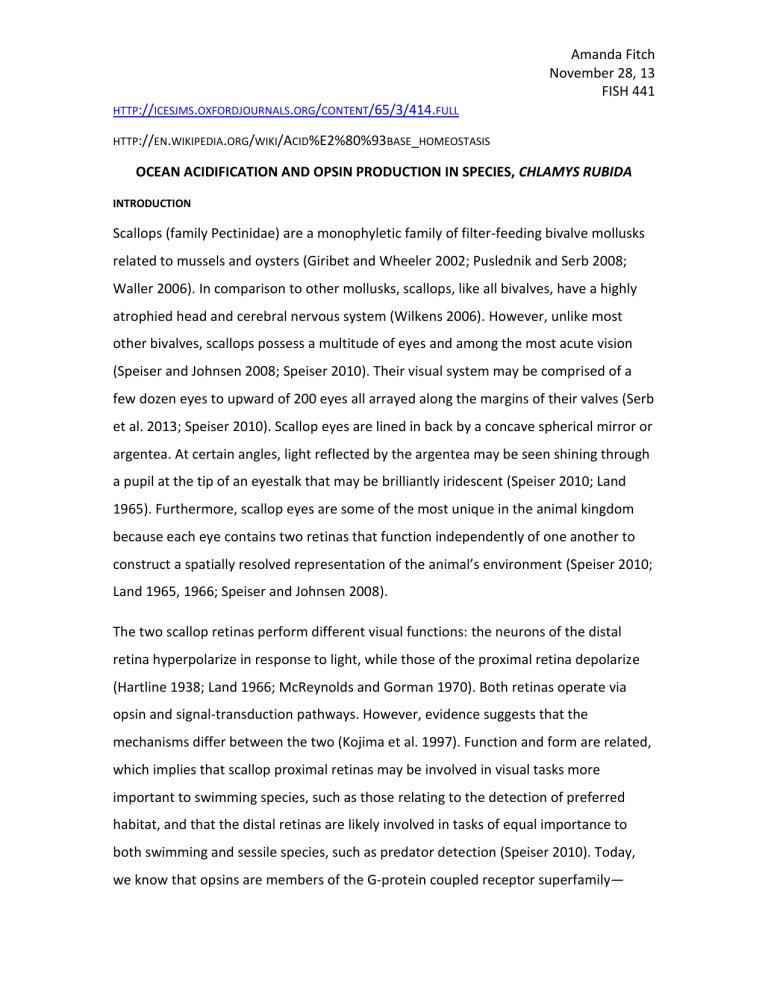
Amanda Fitch
November 28, 13
FISH 441
HTTP :// ICESJMS .
OXFORDJOURNALS .
ORG / CONTENT /65/3/414.
FULL
HTTP :// EN .
WIKIPEDIA .
ORG / WIKI /A CID %E2%80%93 BASE _ HOMEOSTASIS
OCEAN ACIDIFICATION AND OPSIN PRODUCTION IN SPECIES, CHLAMYS RUBIDA
INTRODUCTION
Scallops (family Pectinidae) are a monophyletic family of filter-feeding bivalve mollusks related to mussels and oysters (Giribet and Wheeler 2002; Puslednik and Serb 2008;
Waller 2006). In comparison to other mollusks, scallops, like all bivalves, have a highly atrophied head and cerebral nervous system (Wilkens 2006). However, unlike most other bivalves, scallops possess a multitude of eyes and among the most acute vision
(Speiser and Johnsen 2008; Speiser 2010). Their visual system may be comprised of a few dozen eyes to upward of 200 eyes all arrayed along the margins of their valves (Serb et al. 2013; Speiser 2010). Scallop eyes are lined in back by a concave spherical mirror or argentea. At certain angles, light reflected by the argentea may be seen shining through a pupil at the tip of an eyestalk that may be brilliantly iridescent (Speiser 2010; Land
1965). Furthermore, scallop eyes are some of the most unique in the animal kingdom because each eye contains two retinas that function independently of one another to construct a spatially resolved representation of the animal’s environment (Speiser 2010;
Land 1965, 1966; Speiser and Johnsen 2008).
The two scallop retinas perform different visual functions: the neurons of the distal retina hyperpolarize in response to light, while those of the proximal retina depolarize
(Hartline 1938; Land 1966; McReynolds and Gorman 1970). Both retinas operate via opsin and signal-transduction pathways. However, evidence suggests that the mechanisms differ between the two (Kojima et al. 1997). Function and form are related, which implies that scallop proximal retinas may be involved in visual tasks more important to swimming species, such as those relating to the detection of preferred habitat, and that the distal retinas are likely involved in tasks of equal importance to both swimming and sessile species, such as predator detection (Speiser 2010). Today, we know that opsins are members of the G-protein coupled receptor superfamily—
Amanda Fitch
November 28, 13
FISH 441 proteins with seven transmembrane helices involved in a diverse set of signaling functions, namely image processing, and are found in mantle eyes of scallops (Porter et al. 2011; Kojima et al. 1997).
The inorganic carbon system is one of the most important chemical equilibria in the ocean and is largely responsible for controlling the pH of seawater (Fabry et al 2008).
Oceanic uptake of anthropogenic carbon dioxide (CO
2
), however, is altering the seawater chemistry of the world’s oceans with impending consequences for marine biota, which includes but is not limited to calcium carbonate (CaCO
3
) saturation state and acid-base (metabolic) physiology. In this paper we will discuss pink scallop (Chlamys
rubida) opsin expression under varying light conditions. Additionally, we will be altering the pH and assess expression of opsin in normal pH conditions as well as reduced pH conditions. This will be useful in determining the success potential of this C. rubida in correlation with ocean acidification. C. rubida is important both ecologically as intrinsic part of the food web and economically through aquaculture (Shumway et al., 2006).
MATERIALS AND METHODS
SAMPLE COLLECTION
Pink scallops (C. rubida) are motile marine bivalves occurring exclusively on the Pacific coast of North America from southern California to Alaska (Abbott 1974; MacDonald et al. 1991) . C. rubida were collected during October 2013 with an otter trawl net in the
Strait of Juan de Fuca near Friday Harbor in the San Juan Islands, Washington. There were approximately 45 specimens captured. These specimens were approximately 5 cm in diameter. The scallops were transported on ice and held in the University of
Washington aquarium.
T REATMENT
There were two preliminary treatments performed with one scallop per treatment. This consisted of a light treatment and a dark treatment. The preliminary treatment was done to confirm 1) the effectiveness of the opsin primers that were ordered, and 2) to
Amanda Fitch
November 28, 13
FISH 441 confirm that opsin is produced in positive correlation with light. The specimens were allowed to acclimatize for three days before tissues were extracted from mantle, eye, and gill.
We divided the scallops in groups of four and placed them in tanks that were approximately 50 cm long by 30 cm wide, each filled with equal amounts of seawater.
Each tank represented a different condition: dark + normal pH, dark + elevated pH, light
+ normal pH, and light + elevated pH. There were nine scallops placed in both dark treatments, ten scallops in the light + normal pH treatment, and eleven in the light + elevated pH treatment. To simulate dark, the scallops were enclosed in a tarp. To provide constant light stimulus, a light was placed above the tanks and was left on. Air stones were placed in each treatment. The pH of the treatment seawater was measured twice and read 7.41 and 7.46, respectively. The pH of the control water was also measured twice and read 7.81 and 7.87 respectively. The differences in pH readings likely occurred because the container differed in each reading, the 7.81 pH being in plastic and the later being in glass.
PRIMERS , RNA EXTRACTION , AND QUATITIATIVE POLYMERACE CHAIN REACTION
Tissues from eye, mantle, and gill of C. rubida were stored at – 80 degrees Celsius prior to processing. Primers were obtained from literatureTotal RNA was extracted from tissues using TriReagent according to the manufacturer's protocol. RNA was quantified using Nanodrop 2000c. RNA with a 260/280 ratio between 1.8-2.0 and 260/230 range between 1.5-2.0 would be ideal, however, all samples were used.
First strand cDNA was synthesized using Oligo (dT) primers. Reverse transcription was performed by using the
M-MLV reverse transcriptase with 5 μg DNase treated RNA as template according to the manufacturer's instructions. Real time quantitative PCR was then performed with
SsoFast EvaGreen Supermix. Forward and reverse primers were obtained from literature by Serb et al. 2013 who also were amplifying scallop Gq-opsin gene: Forward
5'ATCTGGCGGTCAGTGACCTCATCTTCT3', forward 5'CATGAGACGCCAGGTCCACC3', reverse 5'GATGGCTGAGAGCATATACCATGG3'.
Amanda Fitch
November 28, 13
FISH 441
PCR AND ELECTROPHORESIS
Because the results from qPCR were unsuccessful we decided to continue optimizing the primers using conventional PCR. We followed the method from the paper Serb et al.
2013 from which the primers were originally obtained. Some slight modifications of the ratio of reagents were made due to differences in mastermix protocols. After PCR was performed we visualized the results using an agarose gel containing ethidium bromide.
The gel was placed in 1xTBE buffer and run for 20 mintues at 110V
RESULTS AND DISCUSSION
Fig 1. Gel electrophoresis results from qPCR for Gq-opsin gene found in scallops.
Results yielded approximately 150 bp
Conventional PCR methods were attempted to optimize primers, however, the results from this new PCR yielded bands on the gel at approximately 150 bp while the opsin gene should be approximately 550 bp. The mostly likely cause for qPCR and PCR amplification failure is because the primer sequence was incorrect. A better approach would be to design primers using NCBI.
It is generally believed that scallop eyes evolved for spotting predators not kind enough to cast shadows ahead of themselves (Morton 2000). Indeed, all scallops respond to the presence of predators by closing their valves up tight. There are some indications,
Amanda Fitch
November 28, 13
FISH 441 however, that scallops use their eyes for more than this one task. For example, scallops are known to extend their tentacles towards novel visual stimuli (Buddenbrock and
Moller-Racke 1953; Wilkens 1981; Wilkens 2006) and there is even behavioral evidence that scallops will swim towards preferred habitats, such as grassbeds, using visual cues
(Hamilton and Koch 1996).
C. rubida posses eyes that are capable of signaling light, and presumably mediate phototaxis, predator evasion by shadow detection or vertical migration, and the entrainment of circadian rhythms (Lamb et al., 2011). The advent of molecular technology has revealed the mechanisms responsible for gene transcription as impacted by environmental gradients, resulting in physiological changes within the organism. This is advantageous in assessing the fate of organisms as they try to cope with environmental changes that are plaguing the future, namely ocean acidification.
REFERENCES
Abbott, R. T.1974. American seashells: the marine Mollusca of the Atlantic and Pacific coasts of North America. Van Nostrand Reinhold Co., New York, NY. 663 p.
Cheng, J. Y., and M. E. DeMont. 1996. Jet-propelled swimming in scallops: Swimming mechanics and ontogenic scaling. Canadian Journal Of Zoology-Revue
Canadienne De Zoologie 74:1734-1748
Fabry, V. J., Seibel, B. A., Feely, R. A., and Orr, J. C. 2008. Impacts of ocean acidification on marine fauna and ecosystem processes. ICES Journal of Marine Science, 65:
414–432.
Giribet, G., and W. Wheeler. 2002. On bivalve phylogeny: a high-level analysis of the
Bivalvia (Mollusca) based on combined morphology and DNA sequence data.Invertebrate Biology 121:271-324.
Koyanagi, M., Takano, K., Tsukamoto, H., Ohtsu, K., Tokunaga, F., and Akihisa Terakita.
2008. Jellyfish vision starts with cAMP signaling mediated by opsin-Gs cascade.
Proceedings for the National Academy of Sciences 105:15576-15580
Amanda Fitch
November 28, 13
FISH 441
Kojima, D., Terakita, A., Ishikawa, T., Tsukahara, Y., Maeda, A., and Y. Shichida. 1997. A novel G o
-mediated phototransduction cascade in scallop visual cells. Journal of
Biological Chemistry 272:22979-22982
Lamb TD, Collin SP, Pugh EN., Jr. 2007. Evolution of the vertebrate eye: opsins, photoreceptors, retina and eye cup. Nature Reviews Neuroscience. 8:960–976.
Land MF. 1965. Image formation by a concave reflector in the eye of the scallop, Pecten
maximus. Journal of Physiology 179:138–53.
Land, M. F. 1966. Activity In Optic Nerve Of Pecten Maximus In Response To Changes In
Light Intensity And To Pattern And Movement In Optical Environment. Journal
Of Experimental Biology 45:83-&
Land, M. F., and D.-E. Nilsson. 2006. General-purpose and special-purpose visual systems. Pp. 167-209 in E. J. Warrant and D.-E. Nilsson, eds. Invertebrate vision.
Cambridge University Press, New York, New York.
Morton, B. 2000. The function of pallial eyes within the Pectinidae, with a description of those present in Patinopecten yessoensis. Pp. 247-255 in E. M. Harper, J. D.
Taylor and J. A. Crane, eds. Evolutionary biology of the Bivalvia. The Geological
Society, London.
Porter, M.L., Blasic, J.R., Bok, M.J, Cameron, E.G., Pringle, T., Cronin, T.W., Robinson, P.R.
2011. Shedding new light on opsin evolution. Proceedings of the Royal Society,
Biological Sciences. 279
Puslednik, L., and J. M. Serb. 2008. Molecular phylogenetics of the Pectinidae (Mollusca:
Bivalvia) and effect of increased taxon sampling and outgroup selection on tree topology. Molecular Phylogenetics And Evolution 48:1178-1188.
Shumway, S. E., Parsons, J. 2006. Scallops: Biology, Ecology and Aquaculture. Elsevier
Science, 2nd Edition.
Speiser, D.I. 2010. The form and function of scallop mantle eyes (Doctoral dissertation).
Retrieved from Duke University libraries.
Speiser, D.I., Johnsen S. 2008. Comparative morphology of the concave mirror eyes of scallops (Pectinoidea). Am Malacol Bull 26:27–33.
Wald G. 1968. Molecular basis of visual excitation. Science 162:230–9.
Amanda Fitch
November 28, 13
FISH 441
Waller, T. R. 2006. New phylogenies of the Pectinidae (Mollusca: Bivalvia): Reconciling morphological and molecular approaches. Pp. 1-44 in S. E. Shumway and G. J.
Parsons, eds. Scallops: Biology, Ecology, and Aquaculture. Elsevier, New York.
Wilkens, L. A. 2006. Neurobiology and behaviour of the scallop. Pp. 317-356 in S. E.
Shumway and G. J. Parsons, eds. Scallops: Biology, Ecology, and Aquaculture.
Elsevier, New York.
Yokoyama S. 2000. Molecular evolution of vertebrate visual pigments. Prog Retin Eye
Res 19:385–419.
Yokoyama S. 2002. Molecular evolution of color vision in vertebrates. Gene 300:69–78.
(http://www.ncbi.nlm.nih. gov/pubmed/12468088).
